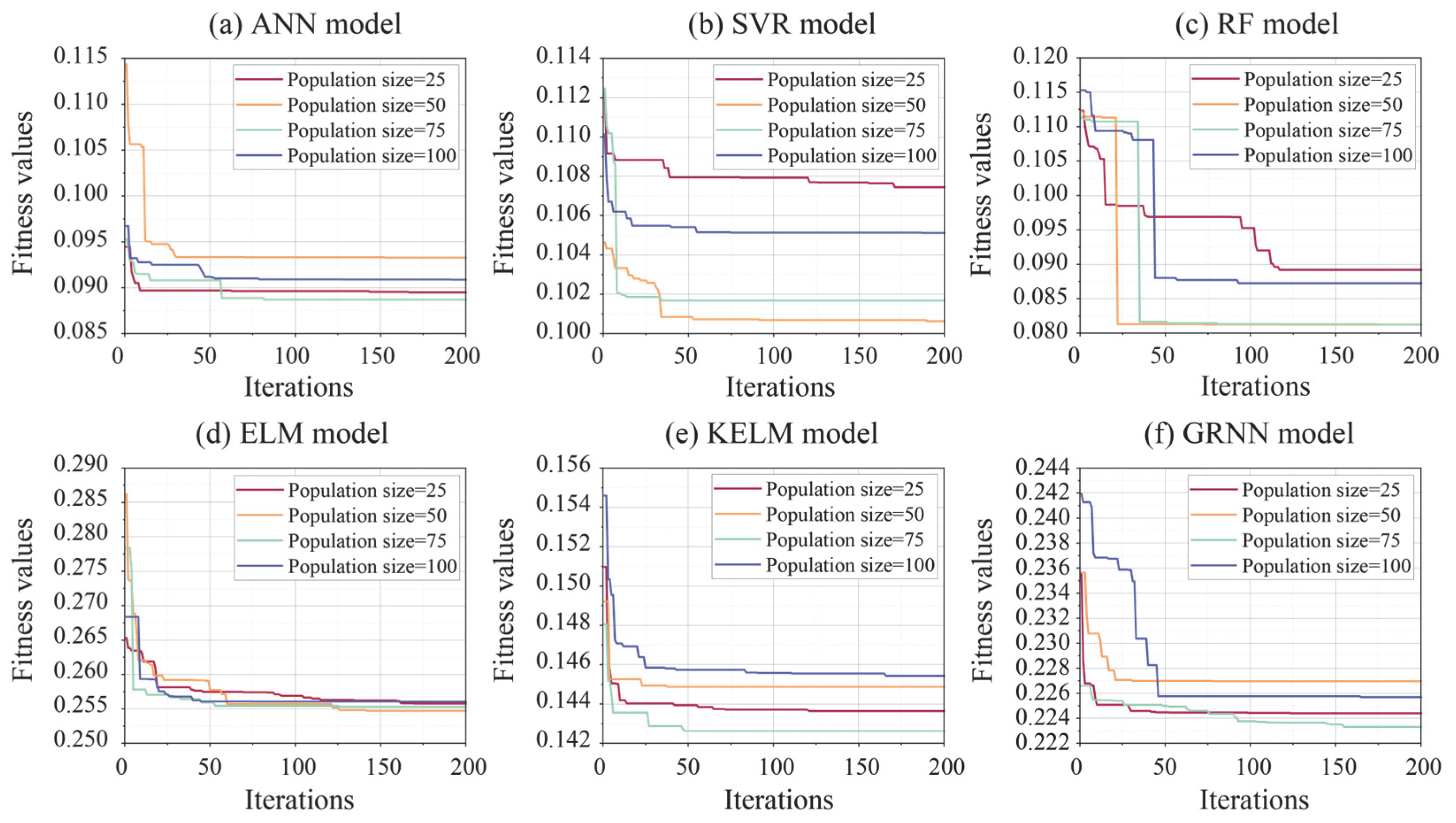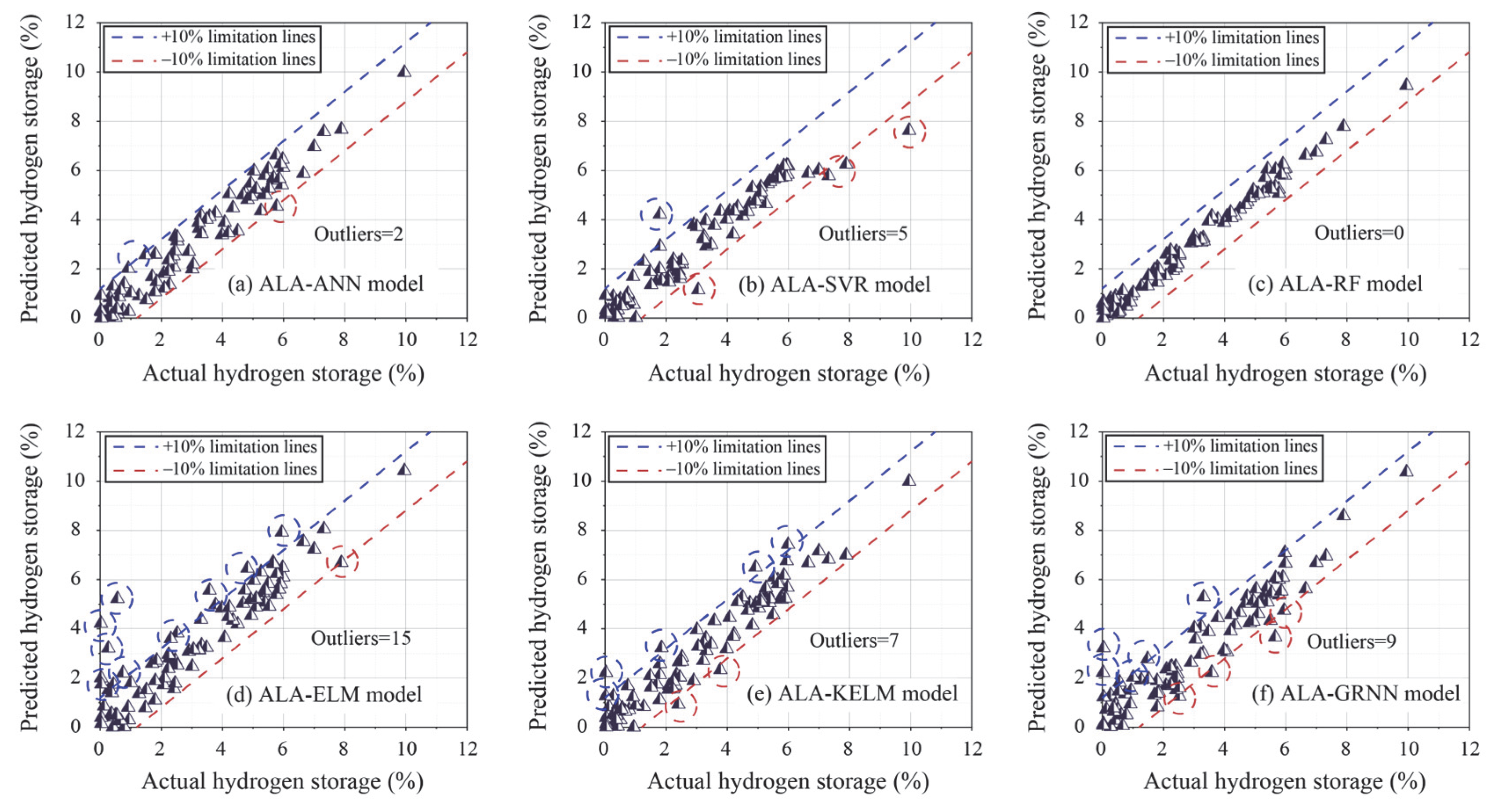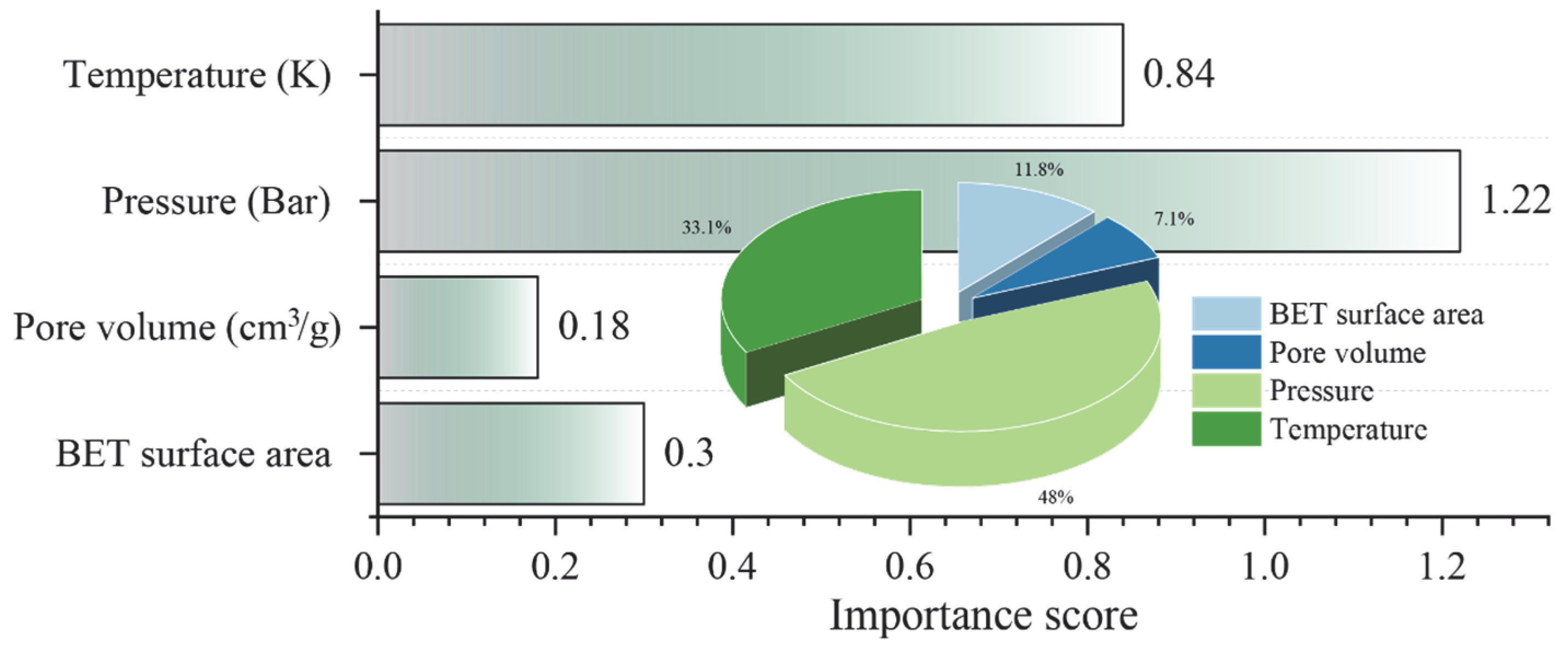Application of Soft Computing Represented by Regression Machine Learning Model and Artificial Lemming Algorithm in Predictions for Hydrogen Storage in Metal-Organic Frameworks
Highlights
- The ALA-RF model achieved the highest accuracy in predicting hydrogen storage in MOFs;
- Pressure is the most influential feature for hydrogen storage prediction;
- ALA significantly improved ML model performance via hyperparameter tuning;
- ALA-RF outperformed prior models using the same dataset.
Abstract
1. Introduction
2. Methodologies
2.1. Artificial Neuron Network (ANN)
2.2. Support Vector Regression (SVR)
2.3. Random Forest (RF)
2.4. Extreme Learning Machine (ELM)
2.5. Kernel Extreme Learning Machine (KELM)
2.6. Generalized Regression Neural Network (GRNN)
2.7. Artificial Lemming Algorithm (ALA)
- (a)
- Population initialization
- (b)
- Long-distance migration (exploration)
- (c)
- Digging holes (exploration)
- (d)
- Foraging for food (exploitation)
- (e)
- Evading natural predators (exploitation)
3. Database
4. Development of Prediction Models
- (1)
- Data preparation
- (3)
- Model evaluation
- (4)
- Model interpretability
5. Results and Discussion
5.1. Hyperparameter Selection
5.2. Model Performance Evaluation
5.3. Model Interpretability
6. Conclusions
- (1)
- The evaluation results demonstrated that the ALA-RF model was the optimal model for predicting hydrogen storage in MOFs, yielding the most satisfactory performance in both the training and testing phases. The values of R2, RMSE, WI, and WAPE were 0.9845, 0.2719, 0.9961, and 0.0667 (training set) and 0.9840, 0.2828, 0.9959, and 0.0714 (test set), respectively. In prediction accuracy, the model provided by this paper outperformed the previous model developed using the same database.
- (2)
- According to the SHAP analysis, pressure was identified as the most important feature for predicting hydrogen storage in MOFs, with the highest importance score of 1.22 among all input features. Temperature exhibited the most significant negative contribution to the prediction results for hydrogen storage.
Author Contributions
Funding
Institutional Review Board Statement
Informed Consent Statement
Data Availability Statement
Acknowledgments
Conflicts of Interest
References
- Farghali, M.; Osman, A.I.; Mohamed, I.M.; Chen, Z.; Chen, L.; Ihara, I.; Yap, P.-S.; Rooney, D.W. Strategies to save energy in the context of the energy crisis: A review. Environ. Chem. Lett. 2023, 21, 2003–2039. [Google Scholar] [CrossRef] [PubMed]
- Kamran, M.; Turzyński, M. Exploring hydrogen energy systems: A comprehensive review of technologies, applications, prevailing trends, and associated challenges. J. Energy Storage 2024, 96, 112601. [Google Scholar] [CrossRef]
- Hu, Y.H.; Zhang, L. Hydrogen storage in metal–organic frameworks. Adv. Mater. 2010, 22, E117–E130. [Google Scholar] [CrossRef]
- Xiong, Q.; Chen, Y.; Yang, D.; Wang, K.; Wang, Y.; Yang, J.; Li, L.; Li, J. Constructing strategies for hierarchically porous MOFs with different pore sizes and applications in adsorption and catalysis. Mater. Chem. Front. 2022, 6, 2944–2967. [Google Scholar] [CrossRef]
- Qureshi, F.; Yusuf, M.; Ahmed, S.; Haq, M.; Alraih, A.M.; Hidouri, T.; Kamyab, H.; Vo, D.-V.N.; Ibrahim, H. Advancements in sorption-based materials for hydrogen storage and utilization: A comprehensive review. Energy 2024, 309, 132855. [Google Scholar] [CrossRef]
- Kancharlapalli, S.; Snurr, R.Q. High-throughput screening of the CoRE-MOF-2019 database for CO2 capture from wet flue gas: A multi-scale modeling strategy. ACS Appl. Mater. Interfaces 2023, 15, 28084–28092. [Google Scholar] [CrossRef] [PubMed]
- Avci, G.; Velioglu, S.; Keskin, S. High-throughput screening of MOF adsorbents and membranes for H2 purification and CO2 capture. ACS Appl. Mater. Interfaces 2018, 10, 33693–33706. [Google Scholar] [CrossRef]
- Edlmann, K.; Haszeldine, S.; Heinemann, N.; Hassanpouryouzband, A.; Thaysen, E. Hystorpor: Unlocking the UK’s Hydrogen Storage; HyStorPor Brief; University of Edinburgh: Edinburgh, UK, 2021. [Google Scholar]
- Yilmaz, G.; Peh, S.B.; Zhao, D.; Ho, G.W. Atomic-and molecular-level design of functional metal–organic frameworks (MOFs) and derivatives for energy and environmental applications. Adv. Sci. 2019, 6, 1901129. [Google Scholar] [CrossRef]
- Burtch, N.C.; Jasuja, H.; Walton, K.S. Water stability and adsorption in metal–organic frameworks. Chem. Rev. 2014, 114, 10575–10612. [Google Scholar] [CrossRef]
- Zhang, C.; Xie, Y.; Xie, C.; Dong, H.; Zhang, L.; Lin, J. Accelerated discovery of porous materials for carbon capture by machine learning: A review. MRS Bull. 2022, 47, 432–439. [Google Scholar] [CrossRef]
- Mei, X.; Li, J.; Zhang, J.; Cui, Z.; Zhou, J.; Li, C. Predicting energy absorption characteristic of rubber concrete materials. Constr. Build. Mater. 2025, 465, 140248. [Google Scholar] [CrossRef]
- Zhang, W.; Wu, C.; Tang, L.; Gu, X.; Wang, L. Efficient time-variant reliability analysis of Bazimen landslide in the Three Gorges Reservoir Area using XGBoost and LightGBM algorithms. Gondwana Res. 2023, 123, 41–53. [Google Scholar] [CrossRef]
- Li, C.; Mei, X. Application of SVR models built with AOA and Chaos mapping for predicting tunnel crown displacement induced by blasting excavation. Appl. Soft Comput. 2023, 147, 110808. [Google Scholar] [CrossRef]
- Nie, F.; Su, X.; Wang, M.; Ma, X.; Ou, K.; Liu, J.; Lin, H. Debonding of asphalt-aggregate interface under coupled moisture and temperature conditions: An atomistic study. Case Stud. Constr. Mater. 2025, 22, e04554. [Google Scholar] [CrossRef]
- Yuan, X.; Suvarna, M.; Low, S.; Dissanayake, P.D.; Lee, K.B.; Li, J.; Wang, X.; Ok, Y.S. Applied machine learning for prediction of CO2 adsorption on biomass waste-derived porous carbons. Environ. Sci. Technol. 2021, 55, 11925–11936. [Google Scholar] [CrossRef]
- Wang, R.; Zhong, Y.; Bi, L.; Yang, M.; Xu, D. Accelerating discovery of metal–organic frameworks for methane adsorption with hierarchical screening and deep learning. ACS Appl. Mater. Interfaces 2020, 12, 52797–52807. [Google Scholar] [CrossRef]
- Anderson, R.; Biong, A.; Gómez-Gualdrón, D.A. Adsorption isotherm predictions for multiple molecules in MOFs using the same deep learning model. J. Chem. Theory Comput. 2020, 16, 1271–1283. [Google Scholar] [CrossRef]
- Wei, F. Synthetic prediction of MOF based on RF and K-nearest neighbor. In Proceedings of the 2024 IEEE 2nd International Conference on Electrical, Automation and Computer Engineering (ICEACE), Changchun, China, 21–31 December 2024; pp. 1005–1011. [Google Scholar]
- Guo, W.; Liu, J.; Dong, F.; Chen, R.; Das, J.; Ge, W.; Xu, X.; Hong, H. Deep learning models for predicting gas adsorption capacity of nanomaterials. Nanomaterials 2022, 12, 3376. [Google Scholar] [CrossRef]
- Pardakhti, M.; Moharreri, E.; Wanik, D.; Suib, S.L.; Srivastava, R. Machine learning using combined structural and chemical descriptors for prediction of methane adsorption performance of metal organic frameworks (MOFs). ACS Comb. Sci. 2017, 19, 640–645. [Google Scholar] [CrossRef]
- Choudhary, K.; Yildirim, T.; Siderius, D.W.; Kusne, A.G.; McDannald, A.; Ortiz-Montalvo, D.L. Graph neural network predictions of metal organic framework CO2 adsorption properties. Comput. Mater. Sci. 2022, 210, 111388. [Google Scholar] [CrossRef]
- Liang, H.; Jiang, K.; Yan, T.A.; Chen, G.H. XGBoost: An optimal machine learning model with just structural features to discover MOF adsorbents of Xe/Kr. ACS Omega 2021, 6, 9066–9076. [Google Scholar] [CrossRef] [PubMed]
- Bergstra, J.; Bengio, Y. Random search for hyper-parameter optimization. J. Mach. Learn. Res. 2012, 13, 281–305. [Google Scholar]
- Chowdhury, C. Bayesian optimization for efficient prediction of gas uptake in nanoporous materials. ChemPhysChem 2024, 25, e202300850. [Google Scholar] [CrossRef]
- Du, Y.; Du, D. Bayesian optimization enhanced neural networks for predicting metal-organic framework morphology: A ZIF-8 synthesis case study. Mater. Lett. 2025, 380, 137738. [Google Scholar] [CrossRef]
- Sun, Y.; DeJaco, R.F.; Li, Z.; Tang, D.; Glante, S.; Sholl, D.S.; Colina, C.M.; Snurr, R.Q.; Thommes, M.; Hartmann, M.; et al. Fingerprinting diverse nanoporous materials for optimal hydrogen storage conditions using meta-learning. Sci. Adv. 2021, 7, eabg3983. [Google Scholar] [CrossRef] [PubMed]
- Agatonovic-Kustrin, S.; Beresford, R. Basic concepts of artificial neural network (ANN) modeling and its application in pharmaceutical research. J. Pharm. Biomed. Anal. 2000, 22, 717–727. [Google Scholar] [CrossRef]
- Vapnik, V.; Guyon, I.; Hastie, T. Support vector machines. Mach. Learn 1995, 20, 273–297. [Google Scholar]
- Ahmad, M.; Kamiński, P.; Olczak, P.; Alam, M.; Iqbal, M.J.; Ahmad, F.; Sasui, S.; Khan, B.J. Development of prediction models for shear strength of rockfill material using machine learning techniques. Appl. Sci. 2021, 11, 6167. [Google Scholar] [CrossRef]
- Li, C.; Zhou, J.; Tao, M.; Du, K.; Wang, S.; Armaghani, D.J.; Mohamad, E.T. Developing hybrid ELM-ALO, ELM-LSO and ELM-SOA models for predicting advance rate of TBM. Transp. Geotech. 2022, 36, 100819. [Google Scholar] [CrossRef]
- Zhang, Y.; Niu, J.; Na, S. A novel nonlinear function fitting model based on FOA and GRNN. Math. Probl. Eng. 2019, 2019, 2697317. [Google Scholar] [CrossRef]
- Xiao, Y.; Cui, H.; Khurma, R.A.; Castillo, P.A. Artificial lemming algorithm: A novel bionic meta-heuristic technique for solving real-world engineering optimization problems. Artif. Intell. Rev. 2025, 58, 84. [Google Scholar] [CrossRef]
- Heraldy, E.; Hidayat, Y.; Firdaus, M. The langmuir isotherm adsorption equation: The monolayer approach. IOP Conf. Ser. Mater. Sci. Eng. 2016, 107, 012067. [Google Scholar]
- Walton, K.S.; Snurr, R.Q. Applicability of the BET method for determining surface areas of microporous metal-organic frameworks. J. Am. Chem. Soc. 2007, 129, 8552–8556. [Google Scholar] [CrossRef] [PubMed]
- Suh, M.P.; Park, H.J.; Prasad, T.K.; Lim, D.W. Hydrogen storage in metal–organic frameworks. Chem. Rev. 2012, 112, 782–835. [Google Scholar] [CrossRef]
- Salehi, K.; Rahmani, M.; Atashrouz, S. Machine learning assisted predictions for hydrogen storage in metal-organic frameworks. Int. J. Hydrogen Energy 2023, 48, 33260–33275. [Google Scholar] [CrossRef]
- Zhang, W.G.; Li, H.R.; Wu, C.Z.; Li, Y.Q.; Liu, Z.Q.; Liu, H.L. Soft computing approach for prediction of surface settlement induced by earth pressure balance shield tunneling. Undergr. Space 2021, 6, 353–363. [Google Scholar] [CrossRef]
- Li, C.; Zhou, J. Prediction and optimization of adverse responses for a highway tunnel after blasting excavation using a novel hybrid multi-objective intelligent model. Transp. Geotech. 2024, 45, 101228. [Google Scholar] [CrossRef]
- Tang, L.; Na, S. Comparison of machine learning methods for ground settlement prediction with different tunneling datasets. J. Rock Mech. Geotech. Eng. 2021, 13, 1274–1289. [Google Scholar] [CrossRef]
- Qiu, J.; Huang, R.; Wang, H.; Wang, F.; Zhou, C. Rate-dependent tensile behaviors of jointed rock masses considering geological conditions using a combined BPM-DFN model: Strength, fragmentation and failure modes. Soil Dyn. Earthq. Eng. 2025, 195, 109393. [Google Scholar] [CrossRef]
- Zhou, J.; Asteris, P.G.; Armaghani, D.J.; Pham, B.T. Prediction of ground vibration induced by blasting operations through the use of the Bayesian Network and random forest models. Soil Dyn. Earthq. Eng. 2020, 139, 106390. [Google Scholar] [CrossRef]
- Zhou, C.; Rui, Y.; Qiu, J.; Wang, Z.; Zhou, T.; Long, X.; Shan, K. The role of fracture in dynamic tensile responses of fractured rock mass: Insight from a particle-based model. Int. J. Coal Sci. Technol. 2025, 12, 39. [Google Scholar] [CrossRef]
- Li, J.; Li, C.; Zhang, S. Application of Six Metaheuristic Optimization Algorithms and Random Forest in the uniaxial compressive strength of rock prediction. Appl. Soft Comput. 2022, 131, 109729. [Google Scholar] [CrossRef]











| Features | Unit | Statistical Indices | |||
|---|---|---|---|---|---|
| Median | Standard Deviation | Minimum | Maximum | ||
| BET surface area | / | 2798.50 | 1225.16 | 150.00 | 6240.00 |
| Pore volume | cm3/g | 1.19 | 0.52 | 0.04 | 3.60 |
| Pressure | Bar | 18.24 | 36.51 | 0.19 | 100.00 |
| Temperature | K | 77.00 | 74.10 | 30.00 | 300.00 |
| Hydrogen storage | % | 2.75 | 2.21 | 0.03 | 9.95 |
| Models | Population Sizes | Hyperparameters | |||
|---|---|---|---|---|---|
| 25 | 50 | 75 | 100 | ||
| ALA-ANN | 0.08949 | 0.09328 | 0.08869 | 0.09088 | Nh: 1; Nn: 8 |
| ALA-SVR | 0.10745 | 0.10063 | 0.10168 | 0.10512 | C: 135.2; k: 1.35 |
| ALA-RF | 0.08920 | 0.08122 | 0.08124 | 0.08724 | Nt: 45; Minleafsize: 1 |
| ALA-ELM | 0.25577 | 0.25471 | 0.25532 | 0.25606 | Nn: 72 |
| ALA-KELM | 0.14364 | 0.14487 | 0.14263 | 0.14543 | C: 114.5; k: 1.87 |
| ALA-GRNN | 0.22441 | 0.22696 | 0.22330 | 0.22568 | Sf: 0.4 |
| Models | Evaluation Indices | |||
|---|---|---|---|---|
| R2 | RMSE | WI | WAPE | |
| ALA-ANN | 0.9649 | 0.4098 | 0.9909 | 0.1031 |
| ALA-SVR | 0.9411 | 0.5306 | 0.9848 | 0.0922 |
| ALA-RF | 0.9845 | 0.2719 | 0.9961 | 0.0667 |
| ALA-ELM | 0.9063 | 0.6693 | 0.9769 | 0.1697 |
| ALA-KELM | 0.9327 | 0.5672 | 0.9834 | 0.1420 |
| ALA-GRNN | 0.9232 | 0.6058 | 0.9808 | 0.1500 |
| Models | Evaluation Indices | |||
|---|---|---|---|---|
| R2 | RMSE | WI | WAPE | |
| ALA-ANN | 0.9649 | 0.4098 | 0.9909 | 0.1031 |
| ALA-SVR | 0.9411 | 0.5306 | 0.9848 | 0.0922 |
| ALA-RF | 0.9845 | 0.2719 | 0.9961 | 0.0667 |
| ALA-ELM | 0.9063 | 0.6693 | 0.9769 | 0.1697 |
| ALA-KELM | 0.9327 | 0.5672 | 0.9834 | 0.1420 |
| ALA-GRNN | 0.9232 | 0.6058 | 0.9808 | 0.1500 |
| Models | Ratio of Training Set to Test Set | R2 | |
|---|---|---|---|
| Training | Test | ||
| ALA-RF | 6:4 | 0.9705 | 0.8917 |
| ALA-RF | 7:3 | 0.9845 | 0.9840 |
| ALA-RF | 8:2 | 0.9875 | 0.9421 |
| ALA-RF | 9:1 | 0.9892 | 0.9213 |
| CMIS | 7:3 | 0.9830 | 0.9780 |
Disclaimer/Publisher’s Note: The statements, opinions and data contained in all publications are solely those of the individual author(s) and contributor(s) and not of MDPI and/or the editor(s). MDPI and/or the editor(s) disclaim responsibility for any injury to people or property resulting from any ideas, methods, instructions or products referred to in the content. |
© 2025 by the authors. Licensee MDPI, Basel, Switzerland. This article is an open access article distributed under the terms and conditions of the Creative Commons Attribution (CC BY) license (https://creativecommons.org/licenses/by/4.0/).
Share and Cite
Zhang, J.; Li, Y.; Li, C.; Mei, X.; Zhou, J. Application of Soft Computing Represented by Regression Machine Learning Model and Artificial Lemming Algorithm in Predictions for Hydrogen Storage in Metal-Organic Frameworks. Materials 2025, 18, 3122. https://doi.org/10.3390/ma18133122
Zhang J, Li Y, Li C, Mei X, Zhou J. Application of Soft Computing Represented by Regression Machine Learning Model and Artificial Lemming Algorithm in Predictions for Hydrogen Storage in Metal-Organic Frameworks. Materials. 2025; 18(13):3122. https://doi.org/10.3390/ma18133122
Chicago/Turabian StyleZhang, Jiamin, Yanzhe Li, Chuanqi Li, Xiancheng Mei, and Jian Zhou. 2025. "Application of Soft Computing Represented by Regression Machine Learning Model and Artificial Lemming Algorithm in Predictions for Hydrogen Storage in Metal-Organic Frameworks" Materials 18, no. 13: 3122. https://doi.org/10.3390/ma18133122
APA StyleZhang, J., Li, Y., Li, C., Mei, X., & Zhou, J. (2025). Application of Soft Computing Represented by Regression Machine Learning Model and Artificial Lemming Algorithm in Predictions for Hydrogen Storage in Metal-Organic Frameworks. Materials, 18(13), 3122. https://doi.org/10.3390/ma18133122








